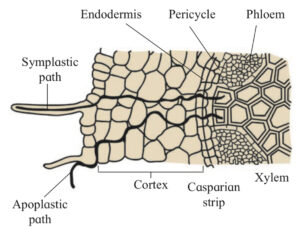1. Water absorption in root hairs occurs through a process involving imbibition, followed by diffusion and osmosis.
2. As water enters the root hair cell, it undergoes an increase in turgor pressure, resulting in turgidity.
3. The root hair cell possesses lower solute concentration (D.ED.) compared to the adjacent cortical cell with higher solute concentration (D.PD.).
4. The inner cortical cell, with a higher osmotic potential, draws water from the root hair cell.
5. Consequently, the root hair cell becomes flaccid, preparing to absorb soil water.
6. This process is then repeated in inner cortical cells.
7. Water moves rapidly through the loosely structured cortical cells, reaching the endodermis and passing through passage cells in the pericycle.
8. The hydrostatic pressure developed in the pericycle forces water into the protoxylem.
